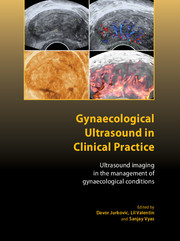 Gynaecological Ultrasound in Clinical Practice
Gynaecological Ultrasound in Clinical Practice Published online by Cambridge University Press: 05 February 2014
Introduction
For many years, urogynaecologists and urologists have relied on cystometry and urethral function tests to evaluate the female lower urinary tract. However, with the improvements in ultrasound imaging techniques, this diagnostic modality has been increasingly used for the assessment of lower urinary tract dysfunction and pelvic floor disorders. Ultrasound has the advantage of being able to visualise fluid-filled structures without the need for contrast medium. It can also demonstrate soft tissue structures such as the kidney, bladder wall, urethral and anal sphincters and surrounding pelvic floor musculature. It also avoids ionising radiation and can be used safely and repeatedly in women of reproductive age. Most ultrasound equipment is transportable and readily available within a gynaecological department. Operating costs of ultrasound are low and the technique should be readily available in most urogynaecological units.
Ultrasound of the lower urinary tract and pelvis
The bony enclosure of the pelvis around the empty bladder and urethra limits the views obtained by ultrasound imaging. Use of the transabdominal, transvaginal, transrectal and transperineal approaches for ultrasound scanning allows for easy visualisation of different aspects of the lower urinary tract. Perineal and transabdominal probes are usually linear array transducers, while transvaginal and transrectal probes are either linear array or sector scanners. Linear array scanners have the disadvantage of being bulky and having low operating frequencies, whereas sector scanners are smaller, more expensive and operate at a higher frequency producing better image resolution. Higher ultrasound frequency provides better image resolution at the expense of decreased depth of penetration owing to increased attenuation.
To save this book to your Kindle, first ensure [email protected] is added to your Approved Personal Document E-mail List under your Personal Document Settings on the Manage Your Content and Devices page of your Amazon account. Then enter the ‘name’ part of your Kindle email address below. Find out more about saving to your Kindle.
Note you can select to save to either the @free.kindle.com or @kindle.com variations. ‘@free.kindle.com’ emails are free but can only be saved to your device when it is connected to wi-fi. ‘@kindle.com’ emails can be delivered even when you are not connected to wi-fi, but note that service fees apply.
Find out more about the Kindle Personal Document Service.
To save content items to your account, please confirm that you agree to abide by our usage policies. If this is the first time you use this feature, you will be asked to authorise Cambridge Core to connect with your account. Find out more about saving content to Dropbox.
To save content items to your account, please confirm that you agree to abide by our usage policies. If this is the first time you use this feature, you will be asked to authorise Cambridge Core to connect with your account. Find out more about saving content to Google Drive.